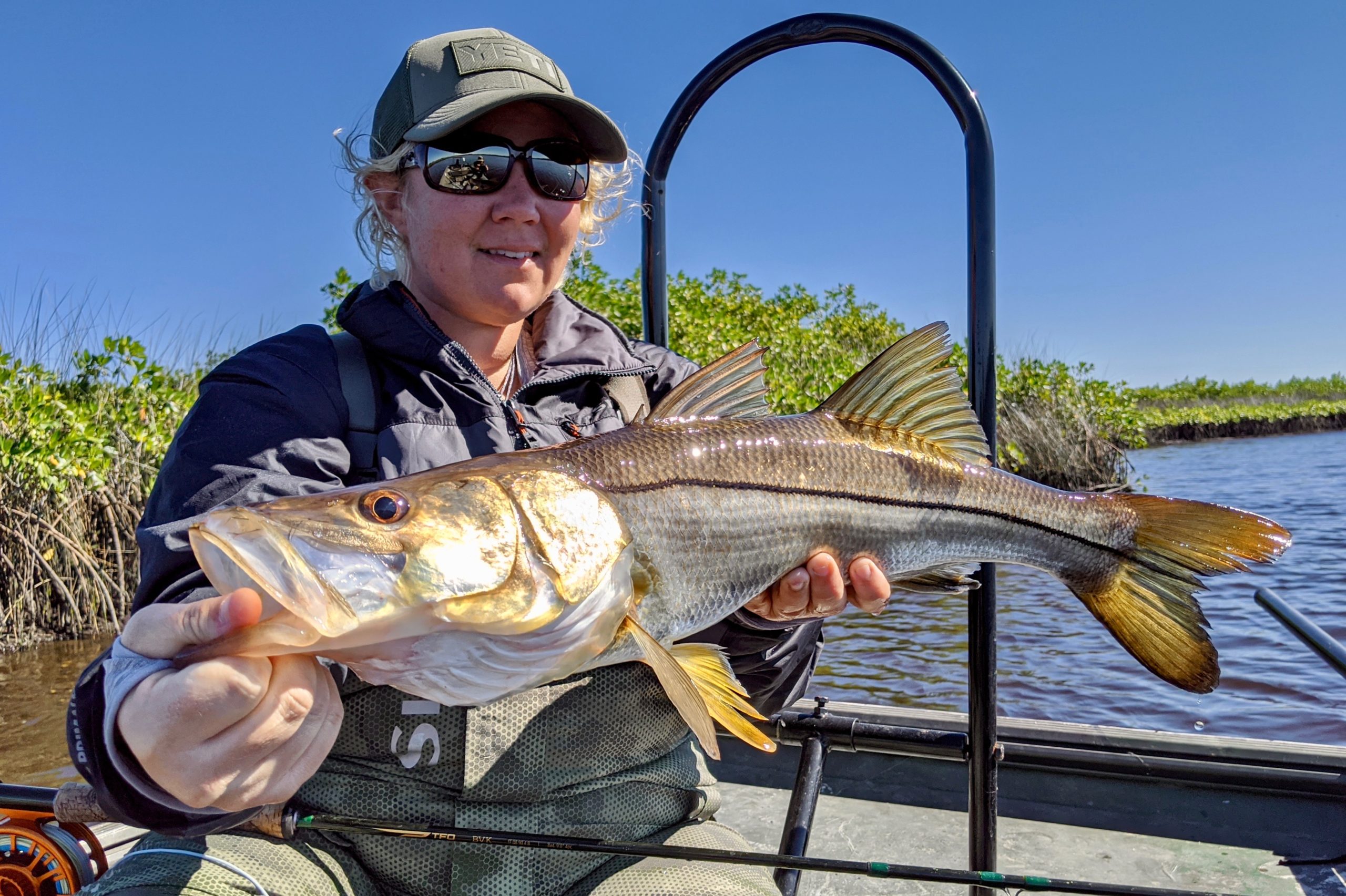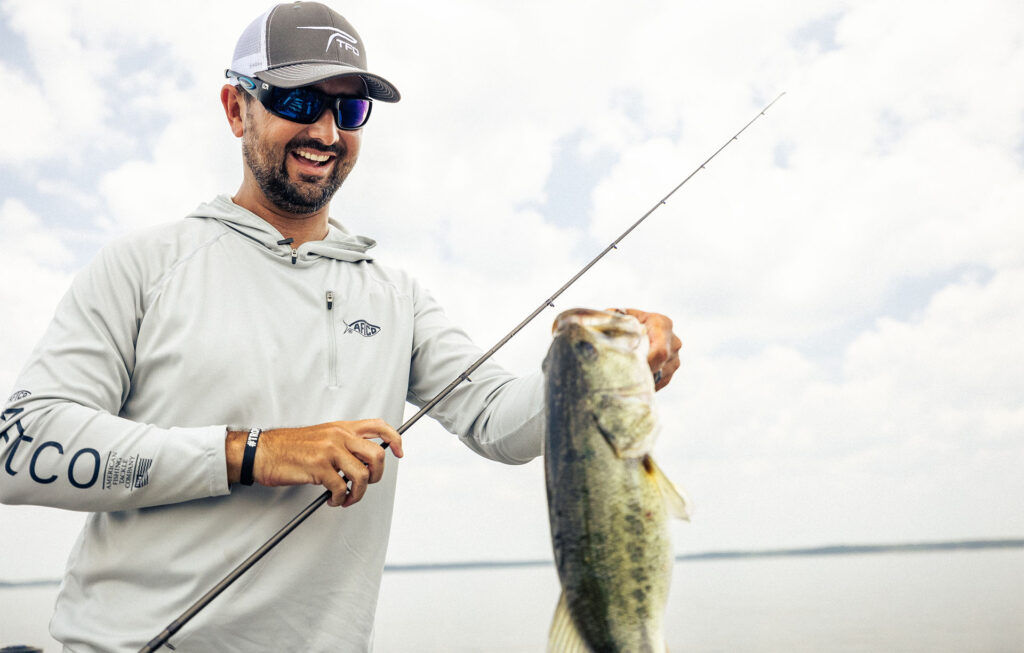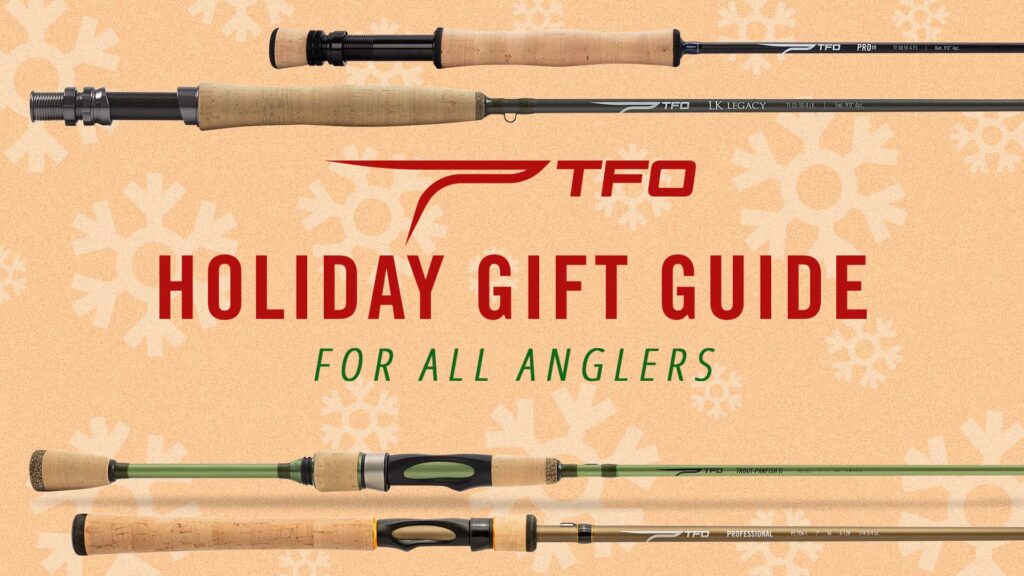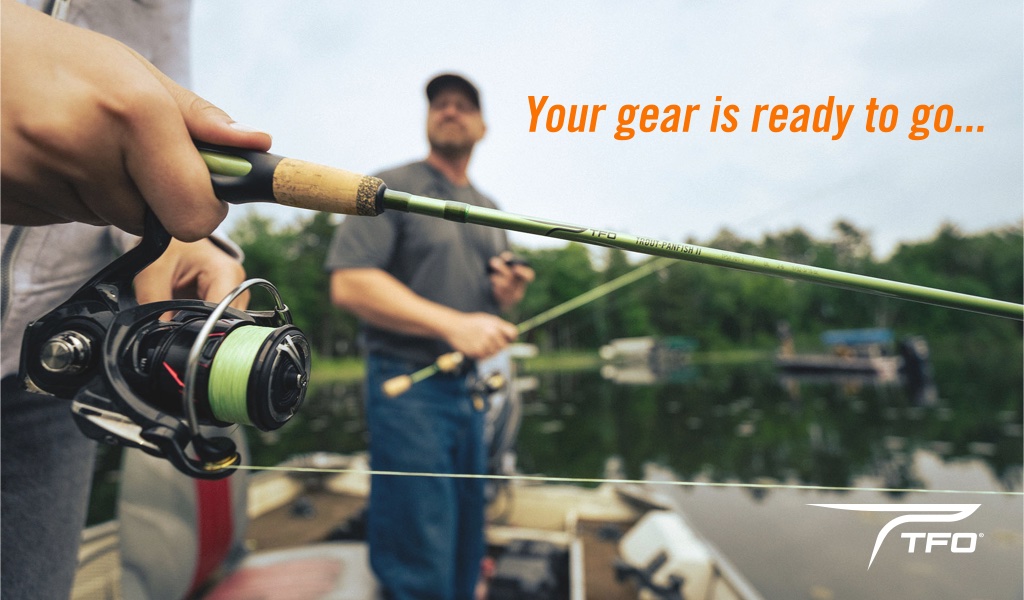When TFO approached me recently about writing a piece on snook, I couldn’t have been more excited. This is a species I have targeted, fought for, and been passionate about my entire life. Everything about this species is absolutely fascinating to me; from their habitat, to their aggressive takes, unique spawning abilities, and their ability to survive in salt or freshwater. These fish are just as intriguing to me now, as they were more than 25 years ago, marking my first encounter with the species. If you have never had a chance to target these amazing creatures, you’ll want to add them to your list after this. However, if you have been as fortunate as myself, and had the joy of experiencing these beauties first hand, I hope you enjoy this read.
A brief back story on my roots; I’m originally from Bethune Beach, FL. If you’re not familiar with that area; It’s the southernmost point of habitable land, on a barrier island. There is no access to the mainland at this point, the rest of the island south is home to an incredible, and protected ecosystem, in the Canaveral National Seashore. The Atlantic side of the island contains one of the most righteous surf breaks on the Florida east coast, while located on the river side of the island, is the world-famous Mosquito Lagoon. Needless to say, I had a pretty well-rounded upbringing between these two bodies of water. My once small hometown changed drastically over the years, something I’m still emotional about to this day. This is a problem that is rampant in Florida, a problem that has many causes and contributing factors. With that change, eight years ago I made the decision to move to the west coast and start over on the Myakka River. This place sucked me in, I became obsessed with learning it, exploring it, and now protecting it. It became apparent within a short time, the same issues the lagoon is struggling with, they were starting to feel the effects of here as well. After 5 years of living here I left my career to focus on conservation, art, and fly fishing full-time. We’ll come back to that though, first we’re going to start this off with one of my favorite subjects; a little bit of History.
Age Before Beauty
Bare with me for a minute while I flood your brain with a little bit of Florida history.
The land we now call Florida began to form, via a combination of volcanic activity, and the deposit of marine sediments. The formation took place along northwest Africa roughly 530 million years ago. If you flash back to your middle school Geography days, you’ll remember a brief, but very important time in history, referred to as Pangea. This occurred due to Florida once being part of Gondwanaland, a super continent, that later divided into Africa and South America. Research shows that Florida then separated from Gondwanaland about 300 million years ago. The state eventually found itself wedged between Gondwanaland and North America, where they then combined, to form; Pangea. When Pangea began to separate, Florida remained behind as part of the continent of North America. Florida then began slipping slowly beneath the surface to become part of North America’s continental shelf. The landmass that is now Florida remained shallowly submerged beneath the ocean. Over time; coral, shellfish, and fish skeletons began accumulating. These mass deposits created a layer of limestone hundreds, and in some places thousands, of feet thick. As the Appalachian Mountains began to erode, sand and clay were then deposited all over Florida’s limestone layer. Much of the quartz sand covering the state today came from the rocks of that mountain chain. One of the many things that captivated me when I first came to this area, was the abundance of limestone formations I’ve located all over the river itself. Rock samples taken from the Myakka in the 1880s date the river to the Pliocene Epoch, 1.8-5.3 million years before the present, when Florida was mostly under water. However, according to University of Florida, Ocala limestone samples from the 1920s suggest that the Florida peninsula dates to the Eocene Epoch, thus dating her to be a whopping 25 to 36 million years ago. Deep grooves in these limestone formations began collecting rainfall in the form of rivers. Though there is a huge conflict in these differing data’s, I personally believe the latter of the two theories. The river and its region became home to; mastodons, mammoths, saber-toothed cats, and even megalodon. With research pointing to megs going extinct atleast 20-million years ago, it personally leads me to believe that the river is much older than some documents lead you to believe.

How Man Found the Myakka
- 12,000 B.C. Humans from eastern Asia cross the newly, but briefly, dry Bering Strait on foot and enter North America, gathering around its deep springs for fresh water.
- 10,200 B.C. First evidence of human habitation on the Myakka. Skeletal remains that were found, near Warm Mineral Springs, in 1959 were carbon-dated to roughly that time.
- 1500 A.D. Florida aboriginals separate into four distinct tribes, including the Calusa tribe on the lower Gulf Coast. The Indians that called this land home believed the area to be sacred. On top of the abundant food source, they believed that storms seemed to disappear or go completely around it.
- 1513 Juan Ponce de Leon’s search for gold treasure, combined with Florida’s legendary Fountain of Youth, led him to Charlotte Harbor and up the Peace and Myakka rivers. He is said, by many, to have found Warm Mineral Springs.
- 1521 Ponce de Leon not only enslaved the Calusa and sold them off, but also brought an abundance of disease upon them. He ultimately died from complications caused by arrow wounds received in an altercation with the Calusa Indians. Unable to cohabitate with the Spaniards, the Calusa eventually left the area. Followed by the Spaniards departing, because they couldn’t survive without the Calusa. Over the years the surrounding land and water went through significant high water, drought, and weather events that pushed what little settlers and aboriginals were left, to the brink. Only the strong survived.

Wild and Scenic
Myakka River State Park opened for visitors in 1942. Within this now, 37,000-acre protected woodland, are hundreds of bird and animal species; Including 80 listed as endangered species. In 1985, Florida officially designated the Myakka for special protection, as the state’s first “Wild and Scenic River.” The entire river from the Upper lake, to Charlotte Harbor, is 66 miles. Nearly 8 months out of the year, especially during the winter months, the river is so shallow you can walk across it. Marshes, swamps, and sloughs also make up the 550-square mile Myakka Basin. This basin full of vast, spongy areas that hold water during the wet season, slowly releasing it to feed the river over the long months when there is no rain. This fragile body of water and ecosystem is why the Myakka needs our attention and preservation, now more than ever. Over the past 20 years, the Myakka has been laced with industrial waste, municipal sewage, agricultural runoff and untold gallons of gasoline, motor oil, and brake fluid. These pollutants come rushing across road surfaces in search of the region’s lowest point. This is all despite the passing of the Clean Water Act, in 1972. Which was placed in response to the unchecked dumping of pollution into our waterways. At the time, two-thirds of the country’s lakes, rivers and coastal waters had become unsafe for fishing or swimming. This included untreated sewage that was being dumped into open water. The most damaging additive since, ironically, has been water. An excess of water, pumped from underground wells to feed farms and mines, has saturated miles of the Myakka Basin, disturbing the river’s ancient cycle of long dry seasons and killing native vegetation. It has become an international laboratory for the study of river habitats, both how to keep them in good health and what to do when they are ailing, as rivers these days usually are. Water is traditionally low in the winter, making invasive plants and fish also a particular concern. Less water means more competition for food and oxygen. West Indian marsh grass is also crowding out native species of vegetation, eliminating food sources that the native fish are partial to. Those native fish, meanwhile, also have invasives of their own to contend with.
As you can tell, I’m extremely passionate about this place. When I was originally asked to write this article, I was sent a list of 10 talking points they’d like me to hit, so far, we’ve covered just one (insert laughter) …

Knowledge Is Power – History & Biology of Snook
Snook are thought to have originated in Central America, and due changes in the earth’s climate they migrated north to Florida. This migration goes back to a great warming trend after the Ice Age, that moved snook northward along the Mexico shoreline. They then followed the Gulf of Mexico to Cuba and Florida, splitting the state and running up along the east and west coasts. Florida proved to be the perfect environment, because snook are described as an estuarine-dependent fish species.
There are five species of snook that inhabit Florida waters; common snook, small scale fat snook, large scale fat snook, tarpon snook, and the swordspine snook.
Formerly known as excellent table fare, snook are making a huge comeback in our waters due to strict conservation efforts.
Within Florida’s diverse estuaries, juvenile snook are commonly found inhabiting; Coastal wetland ponds, island networks, and creeks. In their juvenile stages, snook show a tendency to call lower-salinity conditions home. Snook are also able to osmo-regulate, giving them the ability to adapt and thrive in both high/low salinity habitats. This is referred to as habitat plasticity, an evolutionary adaptation, expressed primarily through reversible physiological change. Which leads me to the most fascinating snook fact; Snook are a protandric hermaphroditic fish species. — Males can change to females as they age.
This transition takes place when snook are between 1-7 years of age or between 12-35 inches in length. This happens quickly, both male, and female sex cells are present in the gonads. During transition, female gonads mature directly from male gonads, after spawning. Thus, making it possible for snook, to spawn once as a male, and then again as a female within the same season.

Spawning
Spawning season typically runs the months of April-October, with peak spawn occurring during June-August. Near-shore waters containing higher salinity values is where their spawning traditionally occurs. Female snook may spawn every two days, during a new or full moon cycle, and release roughly 1.5 million eggs during each spawn. The high salinity in these locations is important to egg survival rates. Salinity provides buoyancy to the eggs carrying them to habitats more suited for survival, these eggs begin to hatch within 28hours. This phenomenon occurs on both the east and west coasts of Florida. Mouths of coastal rivers, major inlets, and the beaches of Gulf of Mexico are prime spawning locations.
Post spawn, the juvenile snook then migrate to the brackish waters of surrounding estuary environments. Once mature, they make their trek to the high salinity waters of the open ocean to join the breeding population. Snook are opportunistic ambush predators, whose feeding habits are attributed to their size and the size of their prey. Which leads us to the age-old question; “Does bigger bait equal bigger fish?”
In the snook world, the answer is, yes. As snook continue to grow they feed on larger and larger prey. Even though this behavior is rare, they even engage in cannibalism, predating upon their own. During the winter months, when adult and juvenile common snook are in close proximity to one another sharing habitat, is when this typically occurs. A feeding pattern referred to as intracohort cannibalism. Juvenile snook that find themselves in this setting may wind up becoming the largest available prey on the menu, thus proving to be nutritionally efficient to prey upon.

Come Fly with Me
Winding through the Old Florida wilderness, it’s the type of landscape that puts your vulnerability in check, a constant reminder of how small you really are in this world. The area I live in is fabled and locally labeled as snook haven, frankly, it is just that. The history, age of the land, and the species that call it home are all-encompassing pieces of knowledge to carry with you. The Myakka is a truly wild unforgiving landscape inhabited by gators, feral hogs, sharks, bobcats, bears, coyotes, panthers, venomous snakes, and large swarms of mosquitoes. When I began immersing myself into this environment, the closest thing I could compare it to would be the deepest parts of the Everglades. This is not the beach, these are not pristine sand flats, it’s not the harbor or the bay. This is as backcountry as it gets.
Do I wade fish here? Yes. Would I conscientiously recommend it to others? No.
Always research your surroundings before entering any body of water. Have a plan, triple check your gear, pay attention to your surroundings, and respect the environment. You are a guest.
Most of what we do in the backcountry is out of an aluminum jon-boat or skiff. Jon likes to even up the ante some days and throw me into a canoe. A very effective method for getting to these fish, you just have to remain extra cat-like with every movement you make.
Casting & Presentation
My number one piece of advice in the pursuit of fly fishing is; Practice, practice, practice!
Practice your cast, have a solid, confident, single and double haul going into these fish.
The techniques Jon and I both use for snook, are applicable to high or low water, and any water clarity. This is where practicing your cast is important, making that cast count no matter the conditions.
Water clarity changes daily here, some days its crystal clear, other days it can be muddy, and most days it resembles sweet tea. Some days, we encounter super low water conditions, with good water clarity. This tends to flush these fish out of their mangrove homes making sight fishing on the shore line possible. When these fish are out in the open, they can eat just as aggressively as they would in their protective structure, but they can see you just as well as you can see them.
The stealth factor and making a good cast first shot, are very important in this instance. However, one of my personal favorite fishing techniques is pitching up-under and into mangroves.
This is technical, this takes time, this takes practice. This is, however, extremely rewarding and efficient in high water, cloudy, or windy conditions. You can use a regular or weed-less flies for this technique. If you do happen to aim a little too high or snag a root, just take it easy pulling it off and it should come right out.
Fly Patterns & Retrieval Methods
Laser minnows, crab, shrimp, varying bait fish patterns and poppers; I’ve thrown all of these for snook and been successful. Now if you’re going to go for the gold on pitching mangroves, be ready to strip hard. The eat is usually very aggressive sometimes launching the fly airborne as if it were a top water plug. Sometimes they’ll eat as soon as it lands, others will ambush it and come out of nowhere, and then there’s the classic v-wake pushing out of the mangroves that then proceeds to finally crush the fly just inches from the boat with half your leader stripped into your rod. In that scenario I hold my breath and there’s usually a lot of praying involved; Praying the line shoots back out as pretty as it stripped through those guides.
These fish will instinctively try to run right back to where they came from, this is where you better stay alert and put the heat to them. 9 times out of 10, this is not a fish you’ll be attempting to get on the reel, most of the fight will be you gaining ground by stripping them in while keeping counter pressure on their head with the rod. The goal is to keep them out of the mangroves and get them to the boat fast. Like tarpon, snook are known for their acrobatics, be ready to fight them the same way when they go for an airborne head-shake.

Knots & Tippet
Much like a tarpon, snook’s mouths are very rough. If not hooked in the very corner of the mouth, or the top of their nose, they can ware through a leader section pretty quickly. I personally use 25-30lb fluoro as my shock tippet for these fish because of that reason. I don’t like break-offs and I really don’t like fish swimming around with gear stuck in their face. I also prefer a simple loop knot for connecting my fly to the tippet, this provides life like action during the retrieve. I’ve seen snook delicately mouth at flies and I’ve watched them smash flies. Every fish is different, retrieval techniques can vary by the fish. I’ve had fish out run my steady “strip, strip, strip” retrieve and end up on top of the fly, completely missing it. I’ve had fish follow-follow-follow, and then all of a sudden turn off, only for the next fish to inhale it. And then I’ve had encounters sight casting where I cast, I give it a couple pops trying to get their attention, they slowly come over, and I was just a millisecond too slow on beginning to work the fly. This results in a fish completely spooking and blowing out due to being able to get too good of a glance at your fly. It can be a delicate dance sometimes with these fish, but they will always keep you wanting more.
Don’t Get Discouraged!
“If at first you don’t succeed, try, try again.” Persistence pays off with these fish, if you happen to totally miff the hook set, pick up your line and fire a cast right back up to the same spot. This technique is extremely effective, this is also why a fast and accurate single haul, is just as important as a clean double haul. I can’t tell you how many times I’ve hooked a fish on the second or third try, just from goofing up the initial hook set. I actually had this happen last week, I was on the bow and had a solid follow out of the mangroves. The fish charged it, ended up being on top of my fly, and completely missed it. I fired a cast right back up to the big boil he left, he ate it again on the second strip, right in the middle of the pause. Resulting in a totally goofed hookset and Jon staring at me from the poling platform like, “Really…??” Stubborn I am, I fired up a third cast, this time Jon speaks up and says, “why would you do that?? That fish isn’t going to eat again, you need to be casting ahead.” As fate would have it, whammy! That fish ate it a third time, this time charging the boat, running under it, and breaking me off. This event lasted all of two seconds, but what a cool fish! We were all high-fives and laughs after that fish.

Fly Lines
Another important tool in your box – selecting the right fly line. Of the many innovations that Lee Wulff has contributed to fly fishing, the Bermuda Triangle Taper fly line is my go-to fly line for anything saltwater. I line all of my saltwater setups with the next weight size up. Which brings us to setups..
Fly Rods
A typical saltwater fishing day, 7/8/9wt rods are my go-to. My favorite setup to toss on a daily basis is an 8wt BVK or an 8/9wt Mangrove, 7wt class would also my Mangrove, and then there’s the 8 and 9wt Axiom II and Axiom II-X. These setups are laser focused and perfect for the saltwater pursuit of any species, especially snook!

But don’t forget that 10wt! This is an important tool, that will lead to regret if left behind. Your 38″+ upper class of snook will need A LOT of heat to keep them from running to structure. There are snook that Jon and I have both come across, where we just look back at each other and can’t believe what we’re seeing. I highly recommend a 10wt for those fish, with a large bait pattern, and a heavier tippet class.
The coolest thing about really big snook, they do not spook easily. They know exactly how big they are and their opportunistic feeding patterns revolve around that. If you can get it in front of them, they will most likely inhale it, but you have to bring the right tools to the fight! These fish are smart, they know their territory well, and will run to any structure they can to break you off quickly.
If by chance you are looking to wade fish, I don’t recommend that here. My best advice is to follow their patterns. If you scroll back up to the Knowledge Is Power section, hidden in there is everything you need to know about finding beach snook.
“A people without the knowledge of their past history, origin and culture, is like a tree without roots.” -M.Garvey

Words and photos by TFO Ambassador Courtney Marie Martin. Sunset snook photo (Photo #2) taken by Eric Shaeffer.
Courtney is based out of Charlotte Harbor, Florida. When not fishing for snook, tarpon and redfish with her partner Jon Lee (TFO Pro Staff) and spending time with her family, Courtney is a fantastic artist, where a lot of her art is inspired by her time on the water. You can find out more about Courtney here.

,







